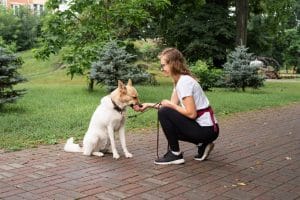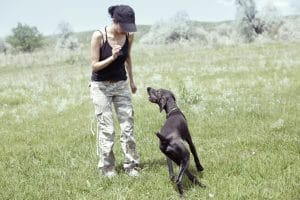![]()
HeelBoyHeel is reader supported. When you buy through any link on our site, we may earn an affiliate commission, but never at any extra cost to you.
There are many different reasons why you may have decided to get a dog. However, whatever the reason, it will be a much more successful partnership if your new best friend understands what is expected of him or her. This is where obedience training comes in. As your dog’s teacher, and a responsible pet owner, you need to know the best way for your dog to learn to grow into a happy, confident and, most importantly, obedient companion.
Below are a few points to help you and your dog with this learning process.
Start With The Right Equipment
Before getting your new dog, you will probably have gone shopping for your new arrival. A lot of the basic essentials will also become part of your dog’s obedience training. His or her dog bed or crate will not just be used as a place to sleep but also a place to learn one of the basic commands, Stay.
As well as food and water bowls, bed or crate, collar, harness and leash, you will find a dog toy and training treats particularly useful in starting the training process. Choose a toy appropriate to the size and age of your dog, something that you can throw and he or she can chase after. When your dog learns to bring the toy back to you to be thrown again, he or she will have learnt another one of the basic command, Come. The tasty treat is another way to reward success besides the essential words of encouragement and stroking.
You will also need a dog brush. With regular brushing, which your dog will learn to enjoy, he or she will also become accustomed to being handled. It will also protect your carpets and floors from a lot of unwanted dog hairs, although not completely!
Basic

By teaching your dog a few basic commands, both you and your dog’s lives will be much easier. Your dog will find security in knowing what you want him or her to do.
The “Sit” command – this is where a dog treat will be useful. Hold the treat in front of your dog’s nose and slowly move the treat upwards. As your dog raises his or her head to follow the treat, gently put your dog in the sitting position if they have not already done so. Use the command “sit” and reward your dog with the treat and lots of fuss and praise. Make sure to do these a few times daily until he or she responds to the command automatically.
Once mastered, it is an extremely useful command which helps to calm your dog down. Make sure to use it before feeding time and when putting on the harness prior to a walk, to take control in exciting situations.
The “Come” command. This part of the training program can be started with your dog on a long leash. When you want your dog to come to you, squat down so that you are on more of a level with your dog. Use the command while gently pulling your dog towards you on the leash. Once again, lots of fuss and a treat when he or she gets to you.
This can be reinforced in an enclosed area without the leash. If your dog has mastered the command “Sit”, ask him or her to sit. You can throw a toy for your dog to chase after and then use the “Come” command when he or she brings the toy back. Fuss, praise and another treat when this is successful. Remember to squat down when using the command and use a normal voice. Your dog will not want to go towards someone who is shouting!
“Down” is a tricky one! The training is much the same as with “Sit”. Hold a dog treat in front of your dog’s nose and this time lower it down to floor level and slide the treat away slowly and his or her body will follow. You can also try stroking your dog’s back, very gently pushing downwards. Whatever you do, don’t force your dog into the “Down” position.
“Down” may be a difficult command for your dog to learn. Initially, your dog will probably not want to adopt a cowering or submissive position. Patience is the key to success with this.
The “Stay” command which you will find very useful. This follows on from the “Sit” command and the basket or crate will be useful with this. Ask your dog to sit, then with an open hand, palm facing your dog, say “Stay”. Take a few steps back, still facing your dog with your hand up. To start with, staying even for a second or two deserves a treat and praise. Gradually increase the distance and time, repeating “Stay”. This is a real exercise in obedience as your dog would rather be with you. However, if you use your dog’s basket he or she will be in a space it knows and it helps your dog to understand where he or she is supposed to stay.
The “Leave” command is for your dog’s safety. Dogs are curious animals and love to investigate something smelly, in fact the smellier the better for your dog! No matter how interesting, their is a small chance that the new “smell” may be something dangerous for your dog. So, you have to teach your dog that you have something more interesting for him or her.
So before you have to compete with a wonderful smell, try this. Put a treat between your hands and let your dog smell it. Transfer the treat to one hand leaving the empty hand in front of your dog. When your dog has stopped trying to get the treat from your empty hand use the command “Leave” and let him or her have the treat from the other hand.
It is a good idea, especially if you have other dogs, to preface the command with your dog’s name. For example, Charlie Come, Charlie Sit etc.
Choose The Best Method For You And Your Dog

The above methods for basic commands are all reward-based and hopefully fun for both of you. It is far easier for your dog (and small children!) to learn through play. You can tailor the methods to suit you, your dog and your situation.
However, there is another method which is aversive-based. This involves punishment and negative reinforcement methods such as unpleasant noises and physical correction. Basically this method involves not rewarding good behaviour but punishing bad behaviour.
The reward-based obedience training is especially preferable for a family pet as your dog does not develop a fear-based relationship when you are hoping for a loving pet.
Consistency Over Perfection
As with most learning it may take quite a few attempts before the penny drops! Try to schedule time every day for a training session or “play time”. Your dog will appreciate your undivided attention and it builds a bond between you. However, even if it takes your dog a little longer than you expect for your dog to master a skill, keep going! Your dog will probably not understand initially what you are expecting him or her to do. Have patience and reward attempts even if they are not perfect yet. It takes time, patience and consistency to achieve perfection!
Learn To Understand Your Dog

Your dog will be constantly watching you, trying to understand you by your vocal tone and body language. So, the least you can do is to try to understand your dog!
There are three types of basic dog intelligence, instinctive, adaptive and obedience. All dogs are born with instinctive intelligence. These are usually shown in breed characteristics. Adaptive intelligence is how your dog learns to fit into a new environment with people and or other animals. Obedience has to be actively learnt. By watching and learning about your dog, you will understand your dog’s likes and dislikes. This information will help you adapt the obedience training sessions for your dog, so that the training will be more pleasurable for both of you and your obedience goals are reached more quickly.
Schedule And Plan Your Training Sessions

Every day you will want to reinforce the simple commands your dog has learnt and use it in appropriate situations. Be consistent, make sure your dog sits before a meal or treat, etc.
However, the quality time for both of you will be the time you set aside for training (play!) sessions. Try to make this a time, when it is just the two of you, without outside distractions, especially no phones! Your dog will soon realise that he or she does not have your full attention and act accordingly. The best relationships are built on mutual respect.
This time is precious, so make the most of it by planning how to use it. Work on helping your dog understand commands your dog has problems with. Try different ways to reinforce the same lesson.
However, don’t beat yourself up if you are not able to do a planned training session or spend as long as you would like on it. The same applies to your dog. If you see that your dog has lost concentration there is really no point in persisting. Either try later or put in a little more when you have time and your dog is more responsive.
When To Get Professional Help
There are times when professional help is very useful and beneficial for both you and your dog. This does not mean that either of you are failing.
If there is already a dog in the home, your new friend will learn a lot of what is expected by following the older dog’s example and you will have had experience of obedience training before. However, if you and your dog are both in at the deep end, it may feel a little overwhelming.
Training classes! If you have read this far then you will want to find a training class that uses positive training techniques. Training classes are great for both of you. It will provide an opportunity for your dog to socialize with other dogs and people, which is an important part of your dog’s development. It also gives you the chance to talk about your dog with other people who will be delighted to talk about their dog!
Be Patient And Believe In The Process
Every dog is different, some learn quickly and some need a little more time. This is especially true of an older dog, but he or she can learn new “tricks” if you have the patience.
So, unless you are patient by nature, your part of the learning process will be patience. This will be time spent enjoying what you are doing with your dog, without thinking and getting stressed about what you have to do next. Your dog will know if you are not giving 100 per cent.
Hopefully your dog will be enjoying the undivided time spent with you and you have to believe that what you are doing will achieve your training goals. If you think it’s not working well your dog will pick up on that as well.
Conclusion
Every one has varying degrees of obedience that they expect from their dog. Your dog has to fit in to your lifestyle and household.
However, to achieve this it is necessary to put in time. Patience, consistency and positive reinforcement are so important. And fun! Your dog, no matter the age, wants to have fun. A happy, enthusiastic learner is going to achieve so much more….and I am not just talking about your dog!
Above all, enjoy the process 🙂